人教版新目标九年级上册Unit 5 What are the shirts made of? Section A 1a-2d 课件+嵌入音频(65张)
文档属性
| 名称 | 人教版新目标九年级上册Unit 5 What are the shirts made of? Section A 1a-2d 课件+嵌入音频(65张) | 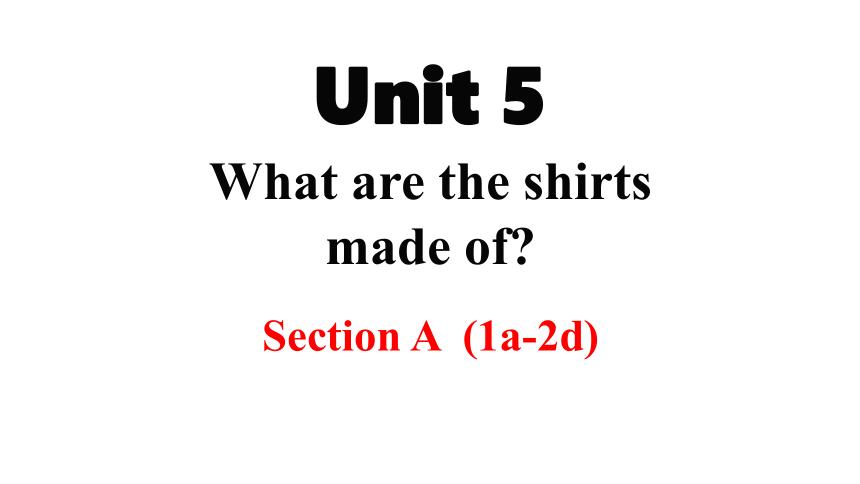 | |
| 格式 | zip | ||
| 文件大小 | 5.5MB | ||
| 资源类型 | 教案 | ||
| 版本资源 | 人教新目标(Go for it)版 | ||
| 科目 | 英语 | ||
| 更新时间 | 2020-10-26 20:32:58 | ||
图片预览

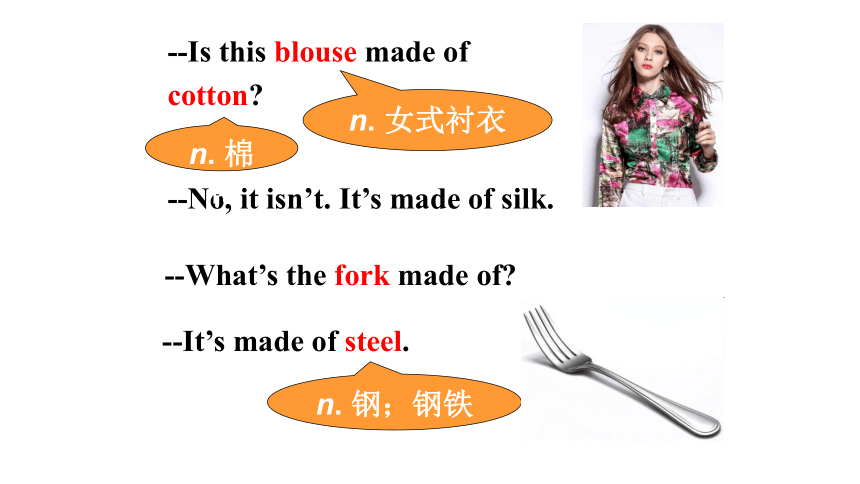
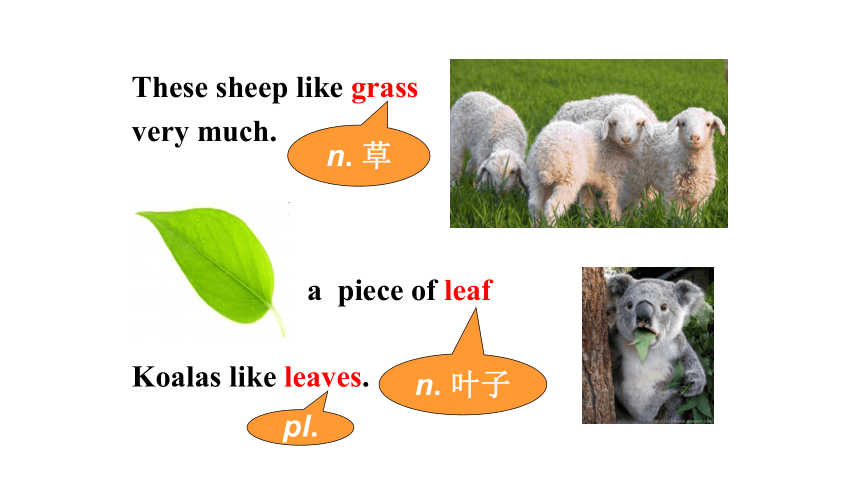
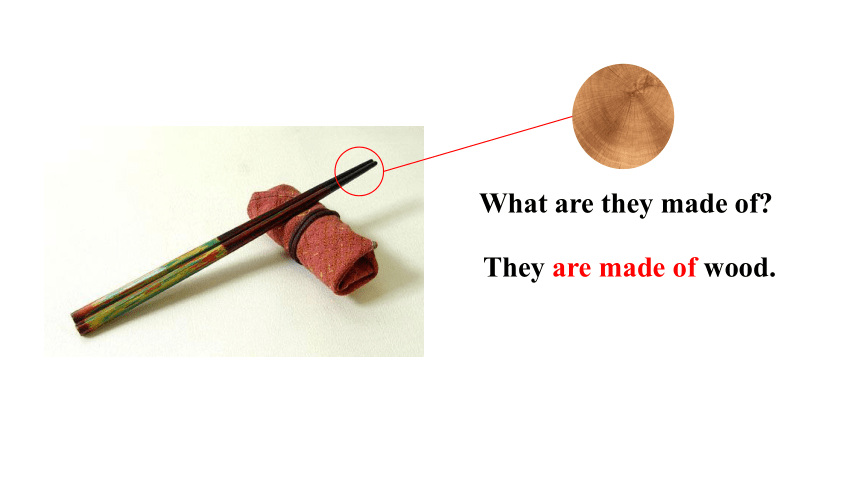

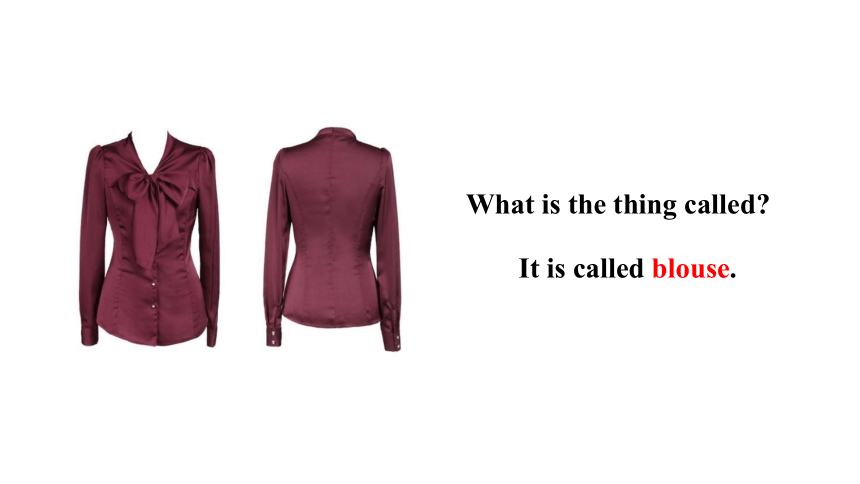
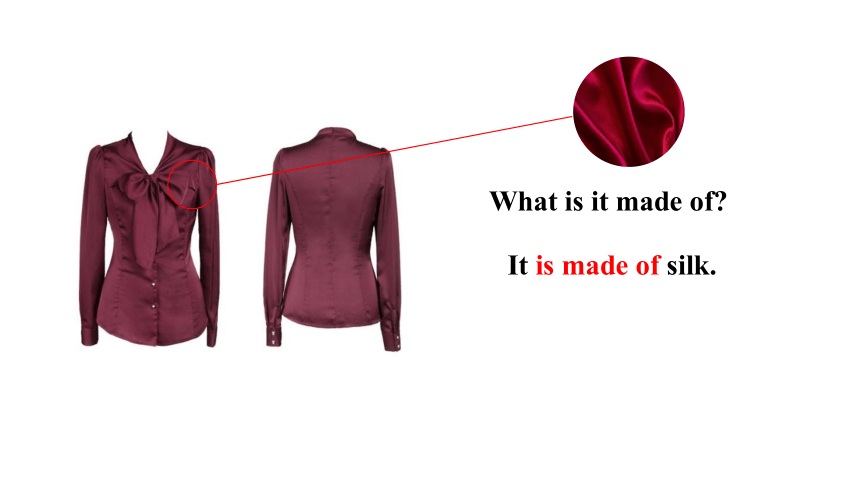
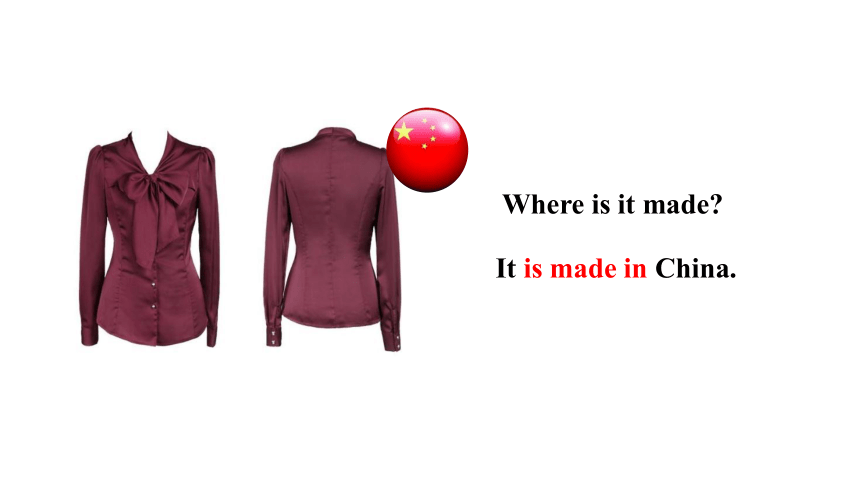
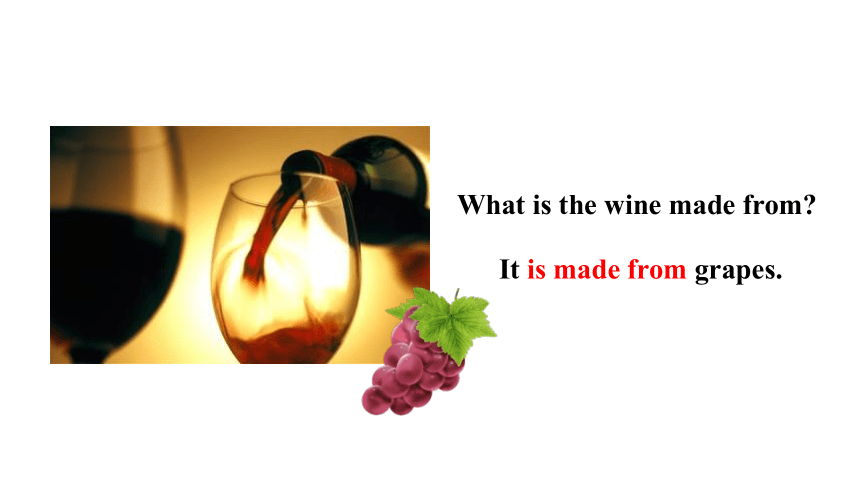
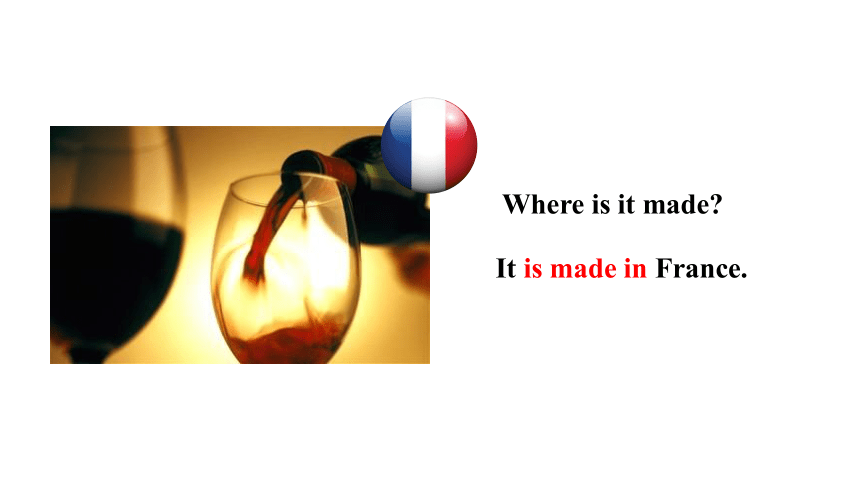

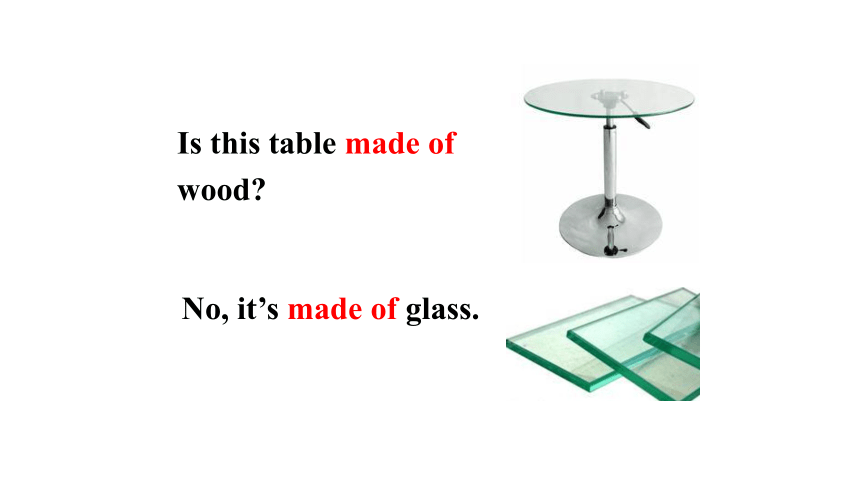
文档简介
(共65张PPT)
Section
A
(1a-2d)
Unit
5
What
are
the
shirts
made
of?
--No,
it
isn’t.
It’s
made
of
silk.
--Is
this
blouse
made
of
cotton?
--It’s
made
of
steel.
--What’s
the
fork
made
of?
n.
女式衬衣
n.
棉花
n.
钢;钢铁
These
sheep
like
grass
very
much.
a
piece
of
leaf
Koalas
like
leaves.
n.
草
n.
叶子
pl.
What
are
they
made
of?
They
are
made
of
wood.
Where
are
they
made?
They
are
made
in
China.
What
is
the
thing
called?
It
is
called
blouse.
What
is
it
made
of?
It
is
made
of
silk.
Where
is
it
made?
It
is
made
in
China.
What
is
the
wine
made
from?
It
is
made
from
grapes.
Where
is
it
made?
It
is
made
in
France.
It
is
made
by
workers.
Who
is
it
made
by?
Is
this
table
made
of
wood?
No,
it’s
made
of
glass.
What
are
these
things
usually
made
of?
Match
them
with
the
materials.
More
than
one
answer
is
possible.
1a
chopsticks
window
coin
stamp
fork
blouse
wood
gold
silver
paper
silk
glass
Matching
Listening
Listen
and
match
the
products
with
what
they
are
made
of
and
where
they
were
made.
Things
Made
of
Made
in
shirts
cotton
Korea
chopsticks
silver
Thailand
ring
steel
America
1b
1.
How
much
did
Susan
pay
for
the
three
shirts?
29
dollars.
2.
What
does
Anita
feel
about
the
three
shirts?
Cheap.
3.
What
are
the
shirts
made
of?
Cotton.
Listen
again
and
answer
the
questions.
4.
Where
were
they
made?
America.
5.
Where
did
Susan
buy
the
chopsticks?
Korea.
6.
How
does
Anita
like
the
chopsticks?
Cool.
7.
What
else
does
Susan
show?
Ring.
8.
Where
was
the
ring
made?
Thailand.
9.
What
will
Susan
do
with
the
ring?
She
will
give
it
to
her
friend.
Practice
the
conversation
in
1a.
Then
make
conversations
using
the
information
in
1b.
This
ring
looks
nice.
Is
it
made
of
silver?
Yes,
and
it
was
made
in
Thailand.
1c
Practice
These
shirts
feel
comfortable.
Are
they
made
of
cotton?
Yes,
and
they
were
made
in
America.
The
chopsticks
look
nice.
Are
they
made
of
silver?
No,
they’re
made
of
steel,
and
they
were
made
in
Korea.
New
words
fair
展览会
environmental
自然环境的
grass
草,草地
leaf
叶子
produce
生产
widely
广泛地,普遍地
be
known
for
以...闻名,为人知晓
process
加工,处理
pack
包装
fair
adj.
公平的;
合理的;
美丽的
fair
n.
an
event
at
which
people
or
businesses
show
and
sell
products
a
book
fair
a
trade
fair
书市
交易会
2a
Listening
Listen
and
check
(√)
the
main
topic
of
Nick
and
Marcus’
conversation.
2a
____
the
science
museum
____
the
art
and
science
fair
____
environmental
protection
____
a
model
plane
____
a
beautiful
painting
____
grass
and
leaves
Listen
again.
Write
short
answers
to
the
questions.
2b
1.
Where
is
the
art
and
science
fair?
_________________________
2.
Do
Nick
and
Marcus
have
to
pay
to
go?
_________________________
3.
What
is
the
model
plane
made
of?
_________________________
4.
What
is
the
painting
made
from?
__________________________
Outside
the
science
museum.
No,
they
don’t.
Wood
and
glass.
Grass,
leaves
and
flowers.
Listen
again
and
mark
true
or
false.
1.
The
art
and
science
fair
is
just
inside
the
science
museum.
2.
The
fair
is
mainly
about
planes
and
paintings.
3.
All
the
works
at
the
fair
were
made
by
university
students.
4.
The
model
plane
is
very
big.
outside
environmental
protection
and
recycling.
5.
The
painting
is
made
of
wool
and
grass.
6.
The
students
are
asked
to
pay
for
the
art
and
science
fair.
7.
The
students
are
interested
in
environmental
protection
and
recycling.
from
grass,
leaves
and
flowers.
invited
to
attend
for
free.
听力原文
在……地方制造
听力原文
be
made
from也表示“由……制成”,但一般指看不出原材料。
be
made
by
sb.
由某人制成
be
made
of
表“由……制成”,一般指能够看出原材料。
Role-play
Make
conversations
using
the
information
in
2a
and
2b.
What
did
you
see
in
the
art
and
science
fair?
2c
I
saw
a
huge
model
plane
and
a
really
beautiful
painting.
What
is
the
model
plane
made
of?
What
is
the
painting
made
from?
The
plane
made
of
wood
and
glass.
The
painting
made
from
grass,
leaves
and
flowers.
Pam:
China
is
famous
for
tea,
right?
Liu
Jun:
Yes,
both
in
the
past
and
now.
Pam:
Where
is
tea
produced
in
China?
Liu
Jun:
Well,
in
many
different
areas.
For
example,
Anxi
and
Hangzhou
are
widely
known
for
their
tea.
Pam:
How
is
tea
produced?
Liu
Jun:
Well,
as
far
as
I
know,
tea
plants
are
grown
on
the
sides
of
mountains.
When
the
leaves
are
ready,they
are
picked
by
hand
and
then
are
sent
for
processing.
Pam:
What
happens
next?
Liu
Jun:
The
tea
is
packed
and
sent
to
many
different
countries
and
places
around
China.
Pam:
It
seems
that
many
people
all
over
the
world
drink
Chinese
tea.
Liu
Jun:
Yes,
people
say
that
tea
is
good
for
both
health
and
business!
2d
Role-play
the
conversation.
2d
2d
Read
the
conversation
and
answer
the
following
questions.
1.
Where
is
tea
produced
in
China?
It
is
produced
in
many
different
areas
2.
How
is
it
grown?
Tea
plants
are
grown
on
the
sides
of
mountains.
When
the
leaves
are
ready,
they
are
picked
by
hand
and
then
are
sent
for
processing.
3.
What
happens
next?
The
tea
is
packed
and
sent
to
many
different
countries
and
places
around
China.
2d
How
is
tea
produced?
Fill
in
the
blanks.
Tea
plants
____________
Tea
leaves
________________
Then
tea
leaves
___________________
The
tea
____________
Finally
the
tea
_________
many
countries
and
places
around
China.
are
grown.
are
picked
by
hand.
are
sent
for
processing.
is
packed.
is
sent
to
Task
2
被动语态。表示主语是谓语动作的承受者。
一般现在时被动语态的基本结构为:
am/is/are+及物动词的-ed形式。
China
______________
tea.
Tea
__________
in
many
different
places
in
China.
For
example,
Anxi
and
Hangzhou
____________________
their
tea.
As
far
as
we
know,
tea
plants
_________
on
the
sides
of
mountains.
When
the
leaves
are
ready,
they
_________
by
hand
and
then
________
for
processing.
Fill
in
the
blanks
according
to
the
conversation.
is
famous
for
is
produced
are
widely
known
for
are
grown
are
picked
are
sent
Task
3
Then
the
tea
__________
and
________
to
many
different
countries
and
places
around
China.
It
seems
that
people
all
over
the
world
drink
Chinese
tea.
Because
tea
__________
both
health
and
business.
is
packed
is
good
for
sent
be
made
of
/
from
...
be
made
in
...?
the
art
and
science
fair
environmental
protection?
be
known
/
famous
/
well-known
for
...
by
hand?
be
sent
for
processing?
由……制成
在……(地方/?时间)制造
艺术与科学博览会
环境保护
以……闻名;为人知晓
用手工;靠手做??
被送去加工
be
made
of与be
made
from
辨析
1.
What
is
the
model
plane
made
of?
这架模型飞机是由什么制成的?
What
is
the
painting
made
from?
这幅画是由什么制成的?
Language
Points
e.g.
Glass
is
made
of
glass.
玻璃杯是由玻璃制成的。
The
paper
is
made
from
wood.
纸是木头做的。
be
made
of
be
made
from
同
两词组都是“由……制成的”之意。
异
指从原料到制成品只发生了形状变化,没有发生本质变化(属物理变化)
指从原料到制成品发生质的变化,无法复原(属化学变化)。
be
made
in
......产的(产地)
+地点/时间
These
cars
are
made
in
Japan/2003.
be
made
by
由......
做的(跟动作的执行者)
The
dumplings
are
made
by
my
mother.
完成下列句子。
1)
葡萄酒是葡萄制成的。
Grape
wine
______________
grapes.
2)
桌子是木材制成的。
The
desks
_____________
wood.
3)
那张报纸被制成了一顶帽子。
The
newspaper
was
__________
a
hat.
4)
那个瓷器是中国产的。
The
china
___________
China.
5)
那个飞机模型是李林做的。
The
model
plane
is
_________
Li
Lin.
is
made
from
are
made
of
made
into
is
made
in
made
by
widely
adv.
广泛地;
普遍地
wide
(形容词)
+
ly
→
widely
(副词)
e.g.
Gas
is
widely
used
for
cooking
and
heating.
天然气被广泛地用于做饭和取暖。
2.
For
example,
Anxi
and
Hangzhou
are
widely
known
for
their
tea.
【语境应用】完成句子
A
long
time
ago
it
was
_________
(广泛地)
believed
that
there
was
life
on
Mars.
(江苏中考)
2.
单项选择
So
far,
Confucius
Institute
(孔子学院)
has
been
set
up
in
many
other
countries.
And
Chinese
is
_______
spoken
in
those
countries.
A.
widely
B.
badly
C.
hardly
widely
A
词条
含义
例句
be
known
/
well-known
/famous
for
以……闻名;
当
The
man
is
known
for
his
good
skills.
Beijing
is
famous
for
the
Great
Wall.
be
famous
/
well-known
/
known
as
...
作为……而闻名
His
uncle
is
known
/
famous
as
an
actor.
be
known
/
famous
/
well-known
to
……所熟知的
Jay
Chou
is
known
to
all
the
1980s
in
China.
【语境应用】完成句子
1)?爱因斯坦作为一位伟大的科学家而闻名。
Einstein
_____________________________
a
great
scientist.
2)?西湖因其美而出名。
The?West
Lake?________________________
_________
its
beauty.?
3)?她是大家所熟知的一名好演员。
She
_______________________________
everyone
as
a
good
actress.
is
known
/
famous
/
well-known
as
is
known
/
famous
/
well-known
for
is
known
/
famous
/
well-known
to
3.
Where
is
tea
produced
in
China?
produce
v.
生产;制造;出产
英语中有produce,
grow和plant三个动词均可用来描述农作物及植物的“种植;生产;生长”,但有所区别。
produce指农作物成产量化地“出产”,或自然地“生长出;长出;结出(果实)”。
e.g.
This
region
produces
over
50%
of
the
country’s
rice.
这个地区出产整个国家50%以上的大米。
These
trees
can
produce
good
apples.
这些树能结出优质的苹果。
grow表示“种植;使生长”,着重指种植以后的栽培、生长过程。
e.g.
These
plants
grow
from
seeds.
这些植物从种子生长而来。
The
villagers
grow
coffee
and
corn
to
sell
in
the
market.
村民们种植咖啡和玉米好拿到市场
上去卖。
plant侧重“栽种;播种”这一行为,指把种子或秧苗种到土壤里使之生长。
e.g.
How
many
trees
have
you
planted
this
year?
今年你们种了多少棵树?
They
planted
tomatoes
and
carrots
in
their
backyard.
他们在后院栽种了西红柿和胡萝
卜。
4.
As
far
as
I
know,
tea
plants
are
grown
on
the
sides
of
mountains.
as
far
as
就……来说;在……范围内
e.g.
As
far
as
I
know,
he
will
be
our
new
English
teacher.
据我所知,他将是我们的新英语老师。
【拓展】
as
far
as
还可以表示“和……一样远”
【语境应用】单项选择
_______
I
know,
May
was
born
in
France
and
grew
up
in
Germany.
(2019山东青岛)
As
long
as
B.
As
far
as
C.
As
soon
as
D.
As
well
as
B
5.
…,
they
are
picked
by
hand
and
then
are
sent
for
processing.
process
v.
加工;
处理
e.g.
America
sent
cotton
to
England
for
processing.
美国把棉花运到英格兰进行加工。
process
n.
工序;过程
in
process
在进行中
e.g.
Building
a
car
is
a
long
process.
制造一辆汽车有很长的工序。
The
bridge
is
in
the
process
of
being
built.
大桥正在建设中。
【拓展】
6.
It
seems
that
many
people
all
over
the
world
drink
Chinese
tea.
It
seems
that
…
似乎......,
看来好像
......
seem是系动词,that引导表语从句
e.g.
It
seems
that
no
one
knows
what
has
happened
in
the
park.
似乎没有人知道在公园里发生了什么事。
7.
People
say
that
tea
is
good
for
both
health
and
business!
be
good
for
有益于……
反义词:be
bad
for
对……有害处
e.g.
Running
is
good
for
your
health.
跑步对你身体有好处。
Watching
TV
too
much
is
bad
for
your
eyes.
电视看得太多对你的眼睛有害。
在英语中,动词有两种语态,即主动语态和被动语态。被动语态的基本结构是“
be
+
及物动词的过去分词”,其中be有人称、数和时态的变化。
一般现在时的被动语态
1.一般现在时被动语态的各种句式结构
肯定式
主语+am/is/are+过去分词(
+
by…)
否定式
主语+am/is/are
+
not
+过去分词
(+by…)
疑问式
Am/Is/Are+主语+过去分词(+
by
…)?
特殊疑问词+
am/is/are+主语+过去分词(+
by
...)?
3.主动语态变为被动语态的方法
第一步:将主动语态的宾语改为被动语态的主语;
第二步:将主动语态的谓语改为“be+及物动词的过
去分词”结构;
第三步:将主动语态的主语改为介词by的宾语,放在
谓语之后(有时可省略)。
如图所示:
They
(主语)grow
(谓语)tea
(宾语)in
the
southeast
of
China.
被动语态:
主动语态:
Tea
(主语)is
grown
(谓语)by
them
in
the
southeast
of
China.
People
play
football
all
over
the
world.
2.
The
old
man
on
TV
tells
a
story
on
Sunday.
3.
Students
listen
to
the
kind
teacher
carefully.
Football
is
played
all
over
the
world
by
people.
A
story
is
told
by
the
old
man
on
TV
on
Sunday.
The
kind
teacher
is
listened
to
carefully
by
students
.
把下列的主动句变为被动句。
I.
根据句意及所给汉语提示,写出所缺单词。
Monkeys
eat
meat,
_______(树叶),
fruit
and
even
eggs.
We
Chinese
people
are
used
to
eating
with
__________(筷子).
3.
My
father
took
some
_______(硬币)
out
of
his
wallet
and
gave
them
to
me.
leaves?
chopsticks
coins
4.
________(钢)
plays
an
important
part
in
the
development
of
industry
(工业).
5.
Most
of
the
food
we
buy
is
__________(加工)
in
some
way.
6.
I
hurt
my
feet
on
a
piece
of
broken
__________
(玻璃).
Steel
processed
7.
Tea
plants
are
_______
(广泛地)
grown
in
the
south
of
China
now.
glass
widely
II.?根据对话内容,在空白处填入恰当的句子,使对话完整、通顺。
A:?Hi,
Larry.
What’s
this
in
your
hand?
B:?Hi,
Paula.
(1)_________________________.
I
bought
it
online
last
week.
A:?How
beautiful
it
is!
(2)____________________?
B:?It
is
used
for
cutting
fruits
into
different
shapes.
A:?Nice!
(3)____________________?
It’s
a
knife
/
It’s
a
kind
of
knife?
What’s
it
used
for?
What’s
it
made
of
B:?Stainless
steel
(不锈钢).
A:?Great!
I
need
tools
made
of
stainless
steel.
(4)____________________?
B:?In?New
York.?
A:?(5)____________________?
B:?8
dollars.
A:?It’s
not
very
expensive.
I’d
like
to
buy
one,
too.
B:?You
can
easily
get
one
online.
Where
was
it
made?
How
much
was
it
/
What
was
the
price
of
it
Thank
you!
Section
A
(1a-2d)
Unit
5
What
are
the
shirts
made
of?
--No,
it
isn’t.
It’s
made
of
silk.
--Is
this
blouse
made
of
cotton?
--It’s
made
of
steel.
--What’s
the
fork
made
of?
n.
女式衬衣
n.
棉花
n.
钢;钢铁
These
sheep
like
grass
very
much.
a
piece
of
leaf
Koalas
like
leaves.
n.
草
n.
叶子
pl.
What
are
they
made
of?
They
are
made
of
wood.
Where
are
they
made?
They
are
made
in
China.
What
is
the
thing
called?
It
is
called
blouse.
What
is
it
made
of?
It
is
made
of
silk.
Where
is
it
made?
It
is
made
in
China.
What
is
the
wine
made
from?
It
is
made
from
grapes.
Where
is
it
made?
It
is
made
in
France.
It
is
made
by
workers.
Who
is
it
made
by?
Is
this
table
made
of
wood?
No,
it’s
made
of
glass.
What
are
these
things
usually
made
of?
Match
them
with
the
materials.
More
than
one
answer
is
possible.
1a
chopsticks
window
coin
stamp
fork
blouse
wood
gold
silver
paper
silk
glass
Matching
Listening
Listen
and
match
the
products
with
what
they
are
made
of
and
where
they
were
made.
Things
Made
of
Made
in
shirts
cotton
Korea
chopsticks
silver
Thailand
ring
steel
America
1b
1.
How
much
did
Susan
pay
for
the
three
shirts?
29
dollars.
2.
What
does
Anita
feel
about
the
three
shirts?
Cheap.
3.
What
are
the
shirts
made
of?
Cotton.
Listen
again
and
answer
the
questions.
4.
Where
were
they
made?
America.
5.
Where
did
Susan
buy
the
chopsticks?
Korea.
6.
How
does
Anita
like
the
chopsticks?
Cool.
7.
What
else
does
Susan
show?
Ring.
8.
Where
was
the
ring
made?
Thailand.
9.
What
will
Susan
do
with
the
ring?
She
will
give
it
to
her
friend.
Practice
the
conversation
in
1a.
Then
make
conversations
using
the
information
in
1b.
This
ring
looks
nice.
Is
it
made
of
silver?
Yes,
and
it
was
made
in
Thailand.
1c
Practice
These
shirts
feel
comfortable.
Are
they
made
of
cotton?
Yes,
and
they
were
made
in
America.
The
chopsticks
look
nice.
Are
they
made
of
silver?
No,
they’re
made
of
steel,
and
they
were
made
in
Korea.
New
words
fair
展览会
environmental
自然环境的
grass
草,草地
leaf
叶子
produce
生产
widely
广泛地,普遍地
be
known
for
以...闻名,为人知晓
process
加工,处理
pack
包装
fair
adj.
公平的;
合理的;
美丽的
fair
n.
an
event
at
which
people
or
businesses
show
and
sell
products
a
book
fair
a
trade
fair
书市
交易会
2a
Listening
Listen
and
check
(√)
the
main
topic
of
Nick
and
Marcus’
conversation.
2a
____
the
science
museum
____
the
art
and
science
fair
____
environmental
protection
____
a
model
plane
____
a
beautiful
painting
____
grass
and
leaves
Listen
again.
Write
short
answers
to
the
questions.
2b
1.
Where
is
the
art
and
science
fair?
_________________________
2.
Do
Nick
and
Marcus
have
to
pay
to
go?
_________________________
3.
What
is
the
model
plane
made
of?
_________________________
4.
What
is
the
painting
made
from?
__________________________
Outside
the
science
museum.
No,
they
don’t.
Wood
and
glass.
Grass,
leaves
and
flowers.
Listen
again
and
mark
true
or
false.
1.
The
art
and
science
fair
is
just
inside
the
science
museum.
2.
The
fair
is
mainly
about
planes
and
paintings.
3.
All
the
works
at
the
fair
were
made
by
university
students.
4.
The
model
plane
is
very
big.
outside
environmental
protection
and
recycling.
5.
The
painting
is
made
of
wool
and
grass.
6.
The
students
are
asked
to
pay
for
the
art
and
science
fair.
7.
The
students
are
interested
in
environmental
protection
and
recycling.
from
grass,
leaves
and
flowers.
invited
to
attend
for
free.
听力原文
在……地方制造
听力原文
be
made
from也表示“由……制成”,但一般指看不出原材料。
be
made
by
sb.
由某人制成
be
made
of
表“由……制成”,一般指能够看出原材料。
Role-play
Make
conversations
using
the
information
in
2a
and
2b.
What
did
you
see
in
the
art
and
science
fair?
2c
I
saw
a
huge
model
plane
and
a
really
beautiful
painting.
What
is
the
model
plane
made
of?
What
is
the
painting
made
from?
The
plane
made
of
wood
and
glass.
The
painting
made
from
grass,
leaves
and
flowers.
Pam:
China
is
famous
for
tea,
right?
Liu
Jun:
Yes,
both
in
the
past
and
now.
Pam:
Where
is
tea
produced
in
China?
Liu
Jun:
Well,
in
many
different
areas.
For
example,
Anxi
and
Hangzhou
are
widely
known
for
their
tea.
Pam:
How
is
tea
produced?
Liu
Jun:
Well,
as
far
as
I
know,
tea
plants
are
grown
on
the
sides
of
mountains.
When
the
leaves
are
ready,they
are
picked
by
hand
and
then
are
sent
for
processing.
Pam:
What
happens
next?
Liu
Jun:
The
tea
is
packed
and
sent
to
many
different
countries
and
places
around
China.
Pam:
It
seems
that
many
people
all
over
the
world
drink
Chinese
tea.
Liu
Jun:
Yes,
people
say
that
tea
is
good
for
both
health
and
business!
2d
Role-play
the
conversation.
2d
2d
Read
the
conversation
and
answer
the
following
questions.
1.
Where
is
tea
produced
in
China?
It
is
produced
in
many
different
areas
2.
How
is
it
grown?
Tea
plants
are
grown
on
the
sides
of
mountains.
When
the
leaves
are
ready,
they
are
picked
by
hand
and
then
are
sent
for
processing.
3.
What
happens
next?
The
tea
is
packed
and
sent
to
many
different
countries
and
places
around
China.
2d
How
is
tea
produced?
Fill
in
the
blanks.
Tea
plants
____________
Tea
leaves
________________
Then
tea
leaves
___________________
The
tea
____________
Finally
the
tea
_________
many
countries
and
places
around
China.
are
grown.
are
picked
by
hand.
are
sent
for
processing.
is
packed.
is
sent
to
Task
2
被动语态。表示主语是谓语动作的承受者。
一般现在时被动语态的基本结构为:
am/is/are+及物动词的-ed形式。
China
______________
tea.
Tea
__________
in
many
different
places
in
China.
For
example,
Anxi
and
Hangzhou
____________________
their
tea.
As
far
as
we
know,
tea
plants
_________
on
the
sides
of
mountains.
When
the
leaves
are
ready,
they
_________
by
hand
and
then
________
for
processing.
Fill
in
the
blanks
according
to
the
conversation.
is
famous
for
is
produced
are
widely
known
for
are
grown
are
picked
are
sent
Task
3
Then
the
tea
__________
and
________
to
many
different
countries
and
places
around
China.
It
seems
that
people
all
over
the
world
drink
Chinese
tea.
Because
tea
__________
both
health
and
business.
is
packed
is
good
for
sent
be
made
of
/
from
...
be
made
in
...?
the
art
and
science
fair
environmental
protection?
be
known
/
famous
/
well-known
for
...
by
hand?
be
sent
for
processing?
由……制成
在……(地方/?时间)制造
艺术与科学博览会
环境保护
以……闻名;为人知晓
用手工;靠手做??
被送去加工
be
made
of与be
made
from
辨析
1.
What
is
the
model
plane
made
of?
这架模型飞机是由什么制成的?
What
is
the
painting
made
from?
这幅画是由什么制成的?
Language
Points
e.g.
Glass
is
made
of
glass.
玻璃杯是由玻璃制成的。
The
paper
is
made
from
wood.
纸是木头做的。
be
made
of
be
made
from
同
两词组都是“由……制成的”之意。
异
指从原料到制成品只发生了形状变化,没有发生本质变化(属物理变化)
指从原料到制成品发生质的变化,无法复原(属化学变化)。
be
made
in
......产的(产地)
+地点/时间
These
cars
are
made
in
Japan/2003.
be
made
by
由......
做的(跟动作的执行者)
The
dumplings
are
made
by
my
mother.
完成下列句子。
1)
葡萄酒是葡萄制成的。
Grape
wine
______________
grapes.
2)
桌子是木材制成的。
The
desks
_____________
wood.
3)
那张报纸被制成了一顶帽子。
The
newspaper
was
__________
a
hat.
4)
那个瓷器是中国产的。
The
china
___________
China.
5)
那个飞机模型是李林做的。
The
model
plane
is
_________
Li
Lin.
is
made
from
are
made
of
made
into
is
made
in
made
by
widely
adv.
广泛地;
普遍地
wide
(形容词)
+
ly
→
widely
(副词)
e.g.
Gas
is
widely
used
for
cooking
and
heating.
天然气被广泛地用于做饭和取暖。
2.
For
example,
Anxi
and
Hangzhou
are
widely
known
for
their
tea.
【语境应用】完成句子
A
long
time
ago
it
was
_________
(广泛地)
believed
that
there
was
life
on
Mars.
(江苏中考)
2.
单项选择
So
far,
Confucius
Institute
(孔子学院)
has
been
set
up
in
many
other
countries.
And
Chinese
is
_______
spoken
in
those
countries.
A.
widely
B.
badly
C.
hardly
widely
A
词条
含义
例句
be
known
/
well-known
/famous
for
以……闻名;
当
The
man
is
known
for
his
good
skills.
Beijing
is
famous
for
the
Great
Wall.
be
famous
/
well-known
/
known
as
...
作为……而闻名
His
uncle
is
known
/
famous
as
an
actor.
be
known
/
famous
/
well-known
to
……所熟知的
Jay
Chou
is
known
to
all
the
1980s
in
China.
【语境应用】完成句子
1)?爱因斯坦作为一位伟大的科学家而闻名。
Einstein
_____________________________
a
great
scientist.
2)?西湖因其美而出名。
The?West
Lake?________________________
_________
its
beauty.?
3)?她是大家所熟知的一名好演员。
She
_______________________________
everyone
as
a
good
actress.
is
known
/
famous
/
well-known
as
is
known
/
famous
/
well-known
for
is
known
/
famous
/
well-known
to
3.
Where
is
tea
produced
in
China?
produce
v.
生产;制造;出产
英语中有produce,
grow和plant三个动词均可用来描述农作物及植物的“种植;生产;生长”,但有所区别。
produce指农作物成产量化地“出产”,或自然地“生长出;长出;结出(果实)”。
e.g.
This
region
produces
over
50%
of
the
country’s
rice.
这个地区出产整个国家50%以上的大米。
These
trees
can
produce
good
apples.
这些树能结出优质的苹果。
grow表示“种植;使生长”,着重指种植以后的栽培、生长过程。
e.g.
These
plants
grow
from
seeds.
这些植物从种子生长而来。
The
villagers
grow
coffee
and
corn
to
sell
in
the
market.
村民们种植咖啡和玉米好拿到市场
上去卖。
plant侧重“栽种;播种”这一行为,指把种子或秧苗种到土壤里使之生长。
e.g.
How
many
trees
have
you
planted
this
year?
今年你们种了多少棵树?
They
planted
tomatoes
and
carrots
in
their
backyard.
他们在后院栽种了西红柿和胡萝
卜。
4.
As
far
as
I
know,
tea
plants
are
grown
on
the
sides
of
mountains.
as
far
as
就……来说;在……范围内
e.g.
As
far
as
I
know,
he
will
be
our
new
English
teacher.
据我所知,他将是我们的新英语老师。
【拓展】
as
far
as
还可以表示“和……一样远”
【语境应用】单项选择
_______
I
know,
May
was
born
in
France
and
grew
up
in
Germany.
(2019山东青岛)
As
long
as
B.
As
far
as
C.
As
soon
as
D.
As
well
as
B
5.
…,
they
are
picked
by
hand
and
then
are
sent
for
processing.
process
v.
加工;
处理
e.g.
America
sent
cotton
to
England
for
processing.
美国把棉花运到英格兰进行加工。
process
n.
工序;过程
in
process
在进行中
e.g.
Building
a
car
is
a
long
process.
制造一辆汽车有很长的工序。
The
bridge
is
in
the
process
of
being
built.
大桥正在建设中。
【拓展】
6.
It
seems
that
many
people
all
over
the
world
drink
Chinese
tea.
It
seems
that
…
似乎......,
看来好像
......
seem是系动词,that引导表语从句
e.g.
It
seems
that
no
one
knows
what
has
happened
in
the
park.
似乎没有人知道在公园里发生了什么事。
7.
People
say
that
tea
is
good
for
both
health
and
business!
be
good
for
有益于……
反义词:be
bad
for
对……有害处
e.g.
Running
is
good
for
your
health.
跑步对你身体有好处。
Watching
TV
too
much
is
bad
for
your
eyes.
电视看得太多对你的眼睛有害。
在英语中,动词有两种语态,即主动语态和被动语态。被动语态的基本结构是“
be
+
及物动词的过去分词”,其中be有人称、数和时态的变化。
一般现在时的被动语态
1.一般现在时被动语态的各种句式结构
肯定式
主语+am/is/are+过去分词(
+
by…)
否定式
主语+am/is/are
+
not
+过去分词
(+by…)
疑问式
Am/Is/Are+主语+过去分词(+
by
…)?
特殊疑问词+
am/is/are+主语+过去分词(+
by
...)?
3.主动语态变为被动语态的方法
第一步:将主动语态的宾语改为被动语态的主语;
第二步:将主动语态的谓语改为“be+及物动词的过
去分词”结构;
第三步:将主动语态的主语改为介词by的宾语,放在
谓语之后(有时可省略)。
如图所示:
They
(主语)grow
(谓语)tea
(宾语)in
the
southeast
of
China.
被动语态:
主动语态:
Tea
(主语)is
grown
(谓语)by
them
in
the
southeast
of
China.
People
play
football
all
over
the
world.
2.
The
old
man
on
TV
tells
a
story
on
Sunday.
3.
Students
listen
to
the
kind
teacher
carefully.
Football
is
played
all
over
the
world
by
people.
A
story
is
told
by
the
old
man
on
TV
on
Sunday.
The
kind
teacher
is
listened
to
carefully
by
students
.
把下列的主动句变为被动句。
I.
根据句意及所给汉语提示,写出所缺单词。
Monkeys
eat
meat,
_______(树叶),
fruit
and
even
eggs.
We
Chinese
people
are
used
to
eating
with
__________(筷子).
3.
My
father
took
some
_______(硬币)
out
of
his
wallet
and
gave
them
to
me.
leaves?
chopsticks
coins
4.
________(钢)
plays
an
important
part
in
the
development
of
industry
(工业).
5.
Most
of
the
food
we
buy
is
__________(加工)
in
some
way.
6.
I
hurt
my
feet
on
a
piece
of
broken
__________
(玻璃).
Steel
processed
7.
Tea
plants
are
_______
(广泛地)
grown
in
the
south
of
China
now.
glass
widely
II.?根据对话内容,在空白处填入恰当的句子,使对话完整、通顺。
A:?Hi,
Larry.
What’s
this
in
your
hand?
B:?Hi,
Paula.
(1)_________________________.
I
bought
it
online
last
week.
A:?How
beautiful
it
is!
(2)____________________?
B:?It
is
used
for
cutting
fruits
into
different
shapes.
A:?Nice!
(3)____________________?
It’s
a
knife
/
It’s
a
kind
of
knife?
What’s
it
used
for?
What’s
it
made
of
B:?Stainless
steel
(不锈钢).
A:?Great!
I
need
tools
made
of
stainless
steel.
(4)____________________?
B:?In?New
York.?
A:?(5)____________________?
B:?8
dollars.
A:?It’s
not
very
expensive.
I’d
like
to
buy
one,
too.
B:?You
can
easily
get
one
online.
Where
was
it
made?
How
much
was
it
/
What
was
the
price
of
it
Thank
you!
同课章节目录
- Unit 1 How can we become good learners.
- Section A
- Section B
- Unit 2 I think that mooncakes are delicious!
- Section A
- Section B
- Unit 3 Could you please tell me where the restroom
- Section A
- Section B
- Unit 4 I used to be afraid of the dark.
- Section A
- Section B
- Unit 5 What are the shirts made of?
- Section A
- Section B
- Review of Units 1-5
- Unit 6 When was it invented?
- Section A
- Section B
- Unit 7 Teenagers should be allowed to choose their
- Section A
- Section B
- Unit 8 It must belong to Carla.
- Section A
- Section B
- Unit 9 I like music that I can dance to.
- Section A
- Section B
- Unit 10 You're supposed to shake hands.
- Section A
- Section B
- Review of Units 6-10
- Unit 11 Sad movies make me cry.
- Section A
- Section B
- Unit 12 Life is full of the unexpected
- Section A
- Section B
- Unit 13 We're trying to save the earth!
- Section A
- Section B
- Unit 14 I remember meeting all of you in Grade 7.
- Section A
- Section B
- Review of Units 11-14
